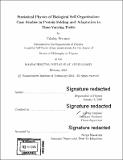| dc.contributor.advisor | Jeremy England. | en_US |
| dc.contributor.author | Perunov, Nikolay | en_US |
| dc.contributor.other | Massachusetts Institute of Technology. Department of Physics. | en_US |
| dc.date.accessioned | 2016-06-22T17:50:03Z | |
| dc.date.available | 2016-06-22T17:50:03Z | |
| dc.date.copyright | 2016 | en_US |
| dc.date.issued | 2016 | en_US |
| dc.identifier.uri | http://hdl.handle.net/1721.1/103232 | |
| dc.description | Thesis: Ph. D., Massachusetts Institute of Technology, Department of Physics, 2016. | en_US |
| dc.description | Cataloged from PDF version of thesis. | en_US |
| dc.description | Includes bibliographical references (pages 119-128). | en_US |
| dc.description.abstract | In this thesis, we use the methods of statistical physics to provide quantitative insights into the behavior of biological systems. In the first half of the thesis, we use equilibrium statistical physics to develop a phenomenological model of how the hydrophobic effect impacts the structure of proteins, and in the second half, we study the phenomenon of adaptation and Darwinian selection from the standpoint of nonequilibrium statistical physics. It has been known for a long time that the hydrophobic effect plays a major role in driving protein folding. However, it has been challenging to translate this understanding into a predictive, quantitative theory of how the full pattern of sequence hydrophobicity in a protein helps to determine its structure. Here, we develop and apply a phenomenological theory of the sequence-structure relationship in globular protein domains. In an effort to optimize parameters for the model, we first analyze the patterns of backbone burial found in single-domain crystal structures and discover that classic hydrophobicity scales derived from bulk physicochemical properties of amino acids are already nearly optimal for prediction of burial using the model. Subsequently, we apply the model to studying structural fluctuations in proteins and establish a means of identifying ligand-binding and protein-protein interaction sites using this approach. In the second half of the thesis, we undertake to address the question of adaptation from the standpoint of physics. Building on past fundamental results in nonequilibrium statistical mechanics, we demonstrate a generalization of the Helmholtz free energy for the finite-time stochastic evolution of driven Newtonian matter. By analyzing this expression, we show a general tendency in a broad class of driven many-particle systems toward self-organization into states formed through reliable absorption and dissipation of work energy from the surrounding environment. We demonstrate how this tendency plays out in the familiar example of Darwinian competition between two exponentially growing self-replicators. Subsequently, we illustrate the more general mechanism by which extra dissipation drives adaptation by analyzing the process of random hopping in driven energy landscapes. | en_US |
| dc.description.statementofresponsibility | by Nikolay Perunov. | en_US |
| dc.format.extent | 128 pages | en_US |
| dc.language.iso | eng | en_US |
| dc.publisher | Massachusetts Institute of Technology | en_US |
| dc.rights | M.I.T. theses are protected by copyright. They may be viewed from this source for any purpose, but reproduction or distribution in any format is prohibited without written permission. See provided URL for inquiries about permission. | en_US |
| dc.rights.uri | http://dspace.mit.edu/handle/1721.1/7582 | en_US |
| dc.subject | Physics. | en_US |
| dc.title | Statistical physics of biological self-organization : case studies in protein folding and adaptation to time-varying fields | en_US |
| dc.title.alternative | Case studies in protein folding and adaptation to time-varying fields | en_US |
| dc.type | Thesis | en_US |
| dc.description.degree | Ph. D. | en_US |
| dc.contributor.department | Massachusetts Institute of Technology. Department of Physics | |
| dc.identifier.oclc | 951540093 | en_US |
